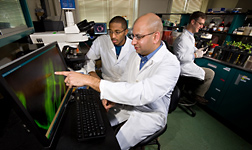ARS Scientists Study the Ins and Outs of E. coli Contamination
Hundreds of strains of Escherichia coli exist, including strains in the human gut that are essential to digestion. Only a few types, like E. coli O157:H7, cause foodborne illness. But food safety experts know it’s possible for some of these pathogenic strains to survive in the environment and contaminate leafy greens that are grown in contaminated soil.
Although levels of E. coli microbes can potentially be controlled on the outsides of raw produce, there is concern that plant roots could take in the pathogens along with nutrients and water. This could allow the bacterium to infiltrate the plant’s internal vascular system and increase the incidence of foodborne illness.
Agricultural Research Service microbiologist Manan Sharma, postdoctoral research associate David Ingram, food technologist Jitu Patel, and microbiologist Patricia Millner all work at the agency’s Environmental Microbial and Food Safety Laboratory in Beltsville, Maryland. The team wanted to find out the odds for possible internal contamination via a plant’s root system.
The researchers modified several strains of E. coli to contain a gene for fluorescence, which allowed them to track the pathogen’s journey in spinach from field to harvest. Some of the modified bacteria they developed were highly pathogenic strains of E. coli O157:H7, and others were nonpathogenic. These strains were developed in collaboration with researchers at the University of Maryland School of Medicine.
They placed the fluorescence gene at a specific location within the chromosome structure of the bacterium where it would not interfere with any essential metabolic functions or stress responses of the cells. This strategy made the cells more likely to survive and fluoresce under stressful conditions within the plant, which in turn gave the scientists a higher level of confidence about their observations.
First the team confirmed that the pathogenic E. coli could survive in the soil for up to 28 days at different levels. They also observed that the fluorescent E. coli cells had been able to migrate into the roots of spinach plants.
The researchers also examined baby spinach plants over the course of 28 days after germination to see whether any of the E. coli strains were taken up past the roots and into the plant’s interior structures. For this part of the study, they grew baby spinach in pasteurized soil and hydroponic media.
Sharma and his colleagues found that at day 28, there was no evidence that E. coli had become “internalized” in leaves or shoots of baby spinach plants grown in soil. They did detect E. coli in hydroponically grown spinach samples analyzed 14 and 21 days after the plants had germinated, but they observed only sporadic, very low levels of bacterial survival in shoot tissue after 28 days.
Sharma believes these findings confirm that although E. coli—including the highly pathogenic strains—can survive in soils, it is highly unlikely that foodborne illness would result from the bacterium becoming internalized through roots in leafy produce.
“I think this study goes a long way in answering the question of how leafy greens can be contaminated by E. coli during production,” Sharma says. “In addition, it gave us an opportunity to develop strains of E. coli for studying these types of phenomena in the future.”—By Ann Perry, Agricultural Research Service Information Staff.
This research supports the USDA priority of ensuring food safety and is part of Food Safety, an ARS national program (#108) described at www.nps.ars.usda.gov.
To reach scientists mentioned in this story, contact Ann Perry, USDA-ARS Information Staff, 5601 Sunnyside Ave., Beltsville, MD 20705-5129; (301) 504-1628.
"ARS Scientists Study the Ins and Outs of E. coli Contamination" was published in the April 2011 issue of Agricultural Research magazine.








